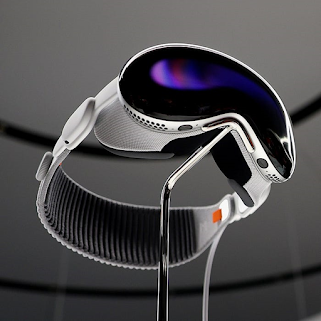Introduction: The highly anticipated launch of the Apple Vision Master marks a significant milestone in the evolution of mixed reality technology. This comprehensive review delves deeper into the headset's standout features, design, and the philosophical considerations it brings. Apple's foray
into spatial computing with the Vision Master positions it not just as a VR headset but as a comprehensive computing platform capable of running applications in a spatial environment.Unboxing Experience:
From the outset, the Vision Master exudes luxury and attention to detail – quintessential traits of Apple products. The premium packaging, complete with a travel case and an impressive cleaning cloth, sets the stage for a superior user experience. The build quality and design of the Vision Star immediately captivate, reflecting Apple's commitment to craftsmanship and aesthetic appeal. The seamless setup process, especially the effortless pairing with an iPhone, underscores the Vision Master's integration into Apple's ecosystem, a crucial aspect of its design philosophy. However, questions arise about comfort during extended use due to the headset's weight.
Design and Build Quality:
The Vision Master stands out in the VR headset market with its premium construction, incorporating magnesium, carbon fiber, and an aluminum enclosure. Its design language echoes familiar Apple products, including the iPhone 6, AirPods Max, and Apple Watch, encapsulating cutting-edge technology in a instantly recognizable form. In contrast to the bulky VR headsets of the past decade, the Vision Star's more compact design is noted for its sophistication and relative portability.
Vision and Front Display:
A key feature of the Vision Master is its front display, designed to extend the wearer's eyes to the real world, aiming to maintain a connection with real interactions. However, the execution receives mixed reactions. While the display is impressive in marketing, it often appears dim and low-resolution in practical use. The reflective glass makes it challenging to see the eyes clearly in various lighting conditions, leading to a somewhat intimidating and disconnected experience.
Hardware and Accessories: Powered by an M2 processor and Apple's new R1 spatial co-processor, the Vision Expert incorporates a cooling system that prevents overheating without noticeable noise. The device includes two types of headbands and various light seals for comfort customization, though concerns about the headset's weight persist for prolonged use. The external battery, a compromise to reduce the headset's weight, provides around two hours of battery life, highlighting the device's design trade-offs.
VisionOS and Spatial Processing: Running on visionOS, based on iPadOS, the Vision Star boasts an extensive application library, a significant advantage over its competitors. The operating system allows for a highly flexible experience with floating windows, supporting applications from three different operating systems: native visionOS apps, iPad apps, and a connection to a Mac for an additional display. However, the Vision Master's approach to spatial processing and AR is somewhat limited, with few real AR interactions and a focus on MR (mixed reality) and VR experiences.
Conclusion: Apple's Vision Star represents a remarkable leap into the future of spatial computing, showcasing impeccable design and a potential new direction for personal computing. However, it also highlights significant compromises that users need to consider, from its hefty price tag to the singular nature of its use. As technology evolves and the ecosystem around visionOS expands, the Vision Master could redefine our expectations for virtual and mixed reality. For now, it provides a fascinating glimpse into the future, with practical limitations reminding us of the challenges still to be overcome in integrating spatial computing into our daily lives.
As the Vision Star continues to evolve with anticipated software updates and an expanding range of compatible applications, it is poised to transform the landscape of mixed reality technology. The Vision Expert isn't just another product; it is a herald of the future, offering a glimpse into how mixed reality can reshape our interactions in the digital world.





0 Comments